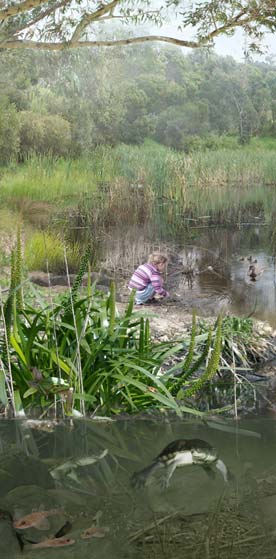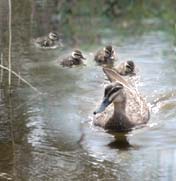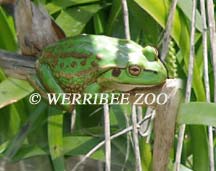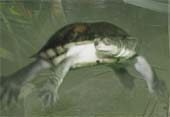Panel 7: Water Quality

In the last few decades a method for measuring fresh water quality and habitat has been developed overseas and in Australia using macroinvertebrates or the small creatures that live in rivers, streams and ponds like mayfly and dragonfly nymphs, beetles, snails, worms, shrimp etc.
This method, known as bioassessment, is useful because macroinvertebrates are widespread and consistent in behaviour in their response to a variety of factors. Furthermore, it is a method that can be understood by members of the community who can also participate in the assessment.
One basic principle, for example, is that water bodies with a high level of diversity are generally in good health while in polluted habitats sensitive species are eliminated and less sensitive species show an increase in numbers. However, this system is not so well developed for estuarine and marine systems.
Animals

BLACK DUCKS – dulum (B)

FROGS
Frogs are ‘amphibians’ and require water to develop for part of their life cycle. The majority have a larval form, which is the tadpole that breathes with gills and a terrestrial, adult form that breathes with lungs. Tadpoles graze on algae and detritus, and after a period of growth that may range from two weeks up to eight months, change into very young frogs that take from one to two years to mature into adults.
(frog) Ngarrert (W) djierrm (B)

Photograph by Kwai Chang-Kum, Werribee Zoo
GROWLING GRASS FROGS
The Growling Grass Frog was widespread but its numbers are declining and several projects are being carried out to rescue it locally around Melbourne. include mussels and a range of other clams cockles and oysters both indigenous and introduced. They attach themselves to rocks or bury in the sediment and are generally filter feeders.

TADPOLE– poorneet
The Common Blue Tongue eats a wide variety of plants and animals, but as it is not very agile, the animals it eats are mostly slow-moving. In suburbia cats and dogs kill many, particularly the young ones.
(large lizard) per-ren-un (W) gaan (B)

FROG SPAWN – galang galang
Frog spawn often appears as small groups of bubbles on the surface of ponds.

SNAKE-NECKED TURTLE
The Snake-necked Turtle has a long neck, which is usually about half the length of its shell. It is almost exclusively carnivorous and eats anything small enough to seize and swallow such as fish, tadpoles, crustaceans, insects and carrion. It is a long-lived creature with a life-span similar to that of humans.
(Turtle/tortoise) bundabun (W) barribin (B)

FLAT-HEADED GUDGEON (fish)
Images of each of the animals in this exhibition are available to purchase in a high-resolution format. All enquiries should be directed to admin@livingmuseum.org.au or by telephone on +613 9318 3544.
